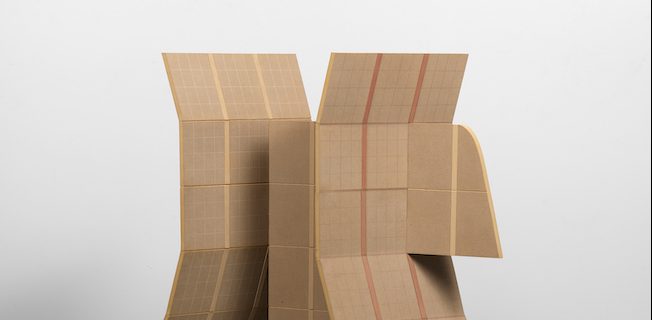The artist’s signature forms conceal critical observations about gender
Diane Simpson’s Samurai 10 (1983) is an impossibly flimsy-looking sculpture. Despite finding its inspiration in the armour of elite Japanese warriors, this wonky freestanding work looks ready to crumple at the slightest breeze. Decorated with pale-red-and-white pencil grids, its intersecting MDF planes pivot and bend in accordance with an unfathomably strange yet satisfying geometry. Simpson’s idiosyncratic aesthetic originated during the mid-1970s, when, as a mature student at the School of the Art Institute of Chicago, she began translating her isometric drawings into three-dimensional objects. Early experiments, such as the relief collage Contained Containers (1976), set the tone with its skewed folding forms composed of scraps of wood, cardboard and printed paper. Its industrial appearance is countered by a gentle domesticity, a duality present throughout this modest exhibition at Nottingham Contemporary – remarkably, the artist’s first museum presentation in Europe.
Drawing has been fundamental to Simpson’s practice for more than 40 years. Each sculpture begins on graph paper as a precise axonometric projection in which objects are rendered obliquely, producing strange, optical distortions. Like a dressmaker’s pattern, the drawings contain the essential information required to fabricate her meticulous models, all made by hand. Each three-dimensional work is here accompanied by its two-dimensional antecedent, such as the elegant Sleeve-Sling(1997), in which a piece of vaguely conical pink cloth overlaid with perforated aluminium is draped over a suspended bar. An adjacent drawing reveals its source to be a flamboyant Elizabethan dress sleeve. While this game of show-and-tell provides fascinating insights into Simpson’s process, the drawings tend to distract and close down readings. Beyond these formal juxtapositions of flatness and volume arise issues of gender, the symbolism and sociology of clothing and complex tensions between abstraction and figuration.
Simpson has acknowledged postminimalists Eva Hesse and Richard Artschwager as influences, as well as postmodern design, art deco and the architectural vernacular of her native Chicago, variously informing her heterodox combinations of pattern, fashion, decor and sculpture. A particularly pleasing example is the curving, finlike form of Court Lady (1985). Inspired by seventeenth-century English court dress and Japanese Sengoku armour, the tall sculpture is laced together with bright red cords that zing against its stained dark exterior. The seemingly disparate clothing styles that inform Simpson’s works are related by their function: the exaggeration and accentuation of certain body parts. Peplum I (2014), for instance, isolates a decorative detail designed to emphasise waistlines: a white skirtlike form with candy-pink edging rests atop a wood and copper base, resembling an occasional table. Though less elegant than other works, it demonstrates the peculiar way that forms coalesce in Simpson’s structures, as details of clothing begin to resemble architectural features that simultaneously suggest items of furniture.
Women’s domestic labour is referenced by Simpson’s Apron series (2000–05) and it’s hard not to read these works as semiautobiographical (for years her art languished in obscurity while her responsibilities as a mother took precedence). Indeed, she has recently noted that Apron III (2001) is an evocation of her childhood kitchen. Its glossy cream and olive-green colours mimic the domestic vernacular of suburban homes in postwar America. A waist-height shelf covered with vintage linoleum sports an abstract art-inspired design, a wry comment perhaps on the challenging integration of career and home life. While such works seem quietly political, Simpson denies any feminist agenda, though it seems hardly coincidental that her interest in domesticity and the social codes of clothing often relate to culturally constructed gender roles and the containment, contortion and concealment of female bodies. Claims to the contrary are another instance of strength masquerading as flimsiness.
Diane Simpson, Sculpture, Drawing, Prints 1976–2014, Nottingham Contemporary, 8 February – 3 May 2020
From the April 2020 issue of ArtReview
